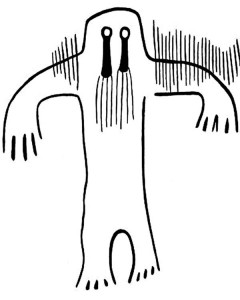By Scott Sandsberry
Three of the animals, though, can only be described in today’s lexicon as an adult male, adult female and child Sasquatch.
The big male, according to Yokuts tribal lore, is Hairy Man, standing on two legs, its arms spread wide, with long hair and, writes Forest Service archeologist Kathy Moskowitz Strain, “large, haunting eyes.” Next to it, with the same hairy, two-legged aspect, are what appear to be the adult female, the “mother,” and her child.
None of the animals shown on Painted Rock are proportionally larger than one would expect; they’re all either life-sized or smaller, as if in the distance.
The painting of Hairy Man is 8 1/2 feet tall.
By the time the first white man saw the Painted Rock pictographs in the 1870s, earlier European settlers of the American west were already well aware of Native Americans’ historical belief in the animal the Central California tribes called Hairy Man.
Many Native Americans, from the Cree people in Manitoba to the Cowichans in British Columbia to the tribes of central and northern California, have through the centuries taken a wide berth to avoid encountering a race or tribe of large, two-legged hairy beasts.
The account of a Methodist missionary found that the Salteaux Indians of Lake Winnipeg “living in dread” of what the missionary himself described as “these imaginary monsters.”
Anthropologists’ response to this has been mixed. Some believe the animals were a creation of tribal folklore meant to keep children in line and convince them not to stray too far from the villages.
But early white traders, settlers and miners often talked about the fervent belief held by the locals in what the whites invariably referred to as “mythical” creatures—which were described much the way Sasquatch is now described.
A 1790 publication related a Hudson’s Bay Company trader’s story about the North Saskatchewan River Indians’ belief in a giant, two-legged beast called the wendingo or windingo. The Indians, noted the trapper, “frequently persuade themselves that they see his track in the moss or snow.”
Two decades later a fur trader named David Thompson found a large footprint, described in historical journals as having been 14 inches long and eight inches wide, near what is now Jasper, Alberta. The print is often referred to as the first Sasquatch footprint found by a white man, though Thompson himself was said to have believed it to be the track of a large grizzly bear.
British Columbia periodicals in the late 1800s and early 1900s carried short news items referencing “the wild man of Vancouver Island” being seen by prospectors and others. And the region’s Kwakiutl Indians related tales of the “Woods Giant” which was routinely described the same way—much larger and hairier than humans, walking on two legs, with deep-set eyes under a thick, protruding forehead.
Below: "This is a hand-drawn replica of Hairy Man as depicted—at 8 1/2 feet tall—in a Central California pictograph estimated to be several hundred years old." (Kathy Moskowitz Strain/Stanislaus National Forest)


Could be anything. The crew of the original Bigfoot videos later said it was a hoax.
ReplyDeleteThe FBI paid them to say that!
ReplyDelete